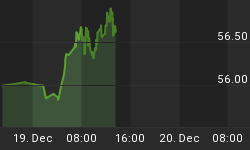I've been writing about bullish technical divergences right after the market hit the January 22-23 intraday low. From the perspective of a volume technician, or a volumist, no technical divergences are more significant than the divergence between volume and price. The flow of volume reflects money flows into and out of stocks. The shift in volume precedes the movement in price. Volume indicators are perhaps the only indicators that are capable of identifying early signals of price movement. So saying, volume indicators continue to diverge from the price and the world of pessimism.
Chart 1 below shows volume weighted Accumulation/Distribution Indicator remains in a strong uptrend after it rebounded from January 22-23 bottom (black circle). Another volume weighted indicator, CMF (Chaikin Money Flow), has also remained in the positive territory since the end of January, except for a brief dip below 0 in early February. That's a duration of 7 weeks (blue circle). And the length of this duration indicates strong accumulation since the CMF hit the January 22-23 bottom.

Chart 1
My proprietary volume weighted Intraday Breadth Performance Composite Index (Chart 2) that calculates intraday shift of market breadth of 3 major exchanges has also been moving in the opposite direction of the overall price performance. The 20-day moving average of this cumulative Intraday Breadth Performance Index had actually moved ahead of the 50-day moving average in mid January (blue arrow) and never looked back.

Chart 2
By all means, positive shift in trading volume means positive money flow into stocks. Cash flows must back up trading volume's bullish claim. Last week's net cash inflow totaling $23.937 billion was the largest inflow since 9/19/2007, according to AMG Data (Chart 3). Interestingly, almost all of it went into the S&P 500 ETF or the S&P 500 index fund. You many also notice that net cash flows hit the bottom in the week ended 1/23/2008 with $13.558 billion cash outflow.

Chart 3
Money flow can also be gauged as a ratio between the total value of uptick trades and the total value of downtick trades. This ratio of the Wilshire 5000 (the broadest stock market index that incorporates almost all the publicly traded stocks headquartered in the U.S.), had also coincidentally reached its lowest point on 1/23/2008. It had since pull out of the trough and gone on to a new high last Friday (Chart 4 below).

Chart 4
Both the volume and the money flow analyses indicate January 23 as the technical bottom. At least that's what the language of the market told us. While the rest of the world was waiting for the other shoe to drop, the market was quietly whispering to us that it had already hit the bottom. And, as the market shifted from distribution mode to accumulation, the sentiment too must also make positive changes.
Market Vane Bullish Consensus, a market sentiment indicator that tracks buy and sell recommendations of leading market advisors, appears to have found its bottom as well in the final week of January when it plummeted all the way down to just 40% (Chart 5 below). The downtrend appears to be reversed as the indicator rounded the bottom.

Chart 5
Leading market advisors weren't the only ones feeling much better after January. The well-to-do had also breathed a sigh of relief. The sentiment of millionaires and affluent investors that have at least $500,000 in investable assets hit rock bottom in January, according to Spectrem Group's Millionaire Investor Index and Affluent Investor Index (Chart 6 below). Both indices saw the largest decline ever that led them to their all time lows in January. But they too had rebounded in February.

Chart 6
With improved volume, money flows, and investor sentiment, it's a statistical probability that the market should rally from here. Yes, spring has sprung, and the market has spun out of the bottom, for now.















